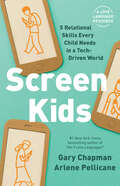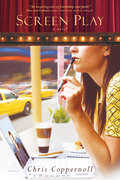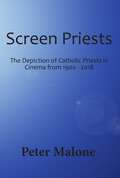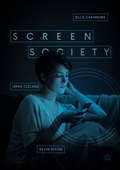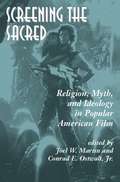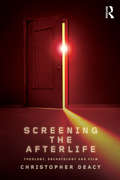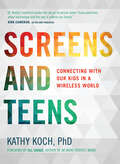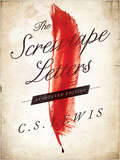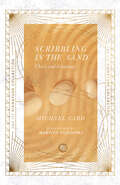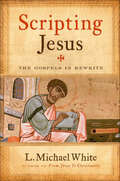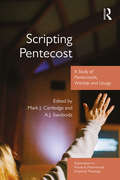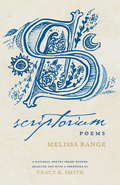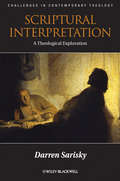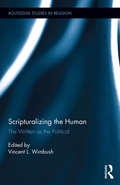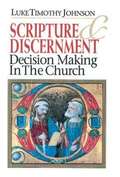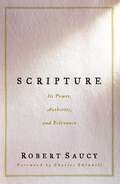- Table View
- List View
Screams in the Night (Sugar Creek Gang Original Series #12)
by Paul HutchensThe tales and travels of the Sugar Creek Gang have passed the test of time, delighting young readers for more than fifty years. Great mysteries with a message, The Sugar Creek Gang series chronicles the faith-building adventures of a group of fun-loving, courageous Christian boys. Your kids will be thrilled, chilled, and inspired to grow as they follow the legendary escapades of Bill Collins, Dragonfly, and the rest of the gang and see how they struggle with the application of their Christian faith to the adventure of life. Travel to Pass Lake, Minnesota, with the Sugar Creek Gang. When the gang arrives, they find themselves in the middle of a mystery. Newspaper reports tell of a kidnapped girl who has not been returned even though the ransom was paid. Will they find the girl and help catch the kidnapper? Join the Sugar Creek Gang on their action-packed trip to Minnesota's lake country and learn about becoming fishers of men.
Screams in the Night (Sugar Creek Gang Original Series #12)
by Paul HutchensThe tales and travels of the Sugar Creek Gang have passed the test of time, delighting young readers for more than fifty years. Great mysteries with a message, The Sugar Creek Gang series chronicles the faith-building adventures of a group of fun-loving, courageous Christian boys. Your kids will be thrilled, chilled, and inspired to grow as they follow the legendary escapades of Bill Collins, Dragonfly, and the rest of the gang and see how they struggle with the application of their Christian faith to the adventure of life. Travel to Pass Lake, Minnesota, with the Sugar Creek Gang. When the gang arrives, they find themselves in the middle of a mystery. Newspaper reports tell of a kidnapped girl who has not been returned even though the ransom was paid. Will they find the girl and help catch the kidnapper? Join the Sugar Creek Gang on their action-packed trip to Minnesota's lake country and learn about becoming fishers of men.
Screen Kids: 5 Relational Skills Every Child Needs in a Tech-Driven World
by Gary Chapman Arlene PellicaneHas Technology Taken Over Your Home?In this digital age, children spend more time interacting with screens and less time playing outside, reading a book, or interacting with family. Though technology has its benefits, it also has its harms. In Screen Kids Gary Chapman and Arlene Pellicane will empower you with the tools you need to make positive changes. Through stories, science, and wisdom, you&’ll discover how to take back your home from an overdependence on screens. Plus, you&’ll learn to teach the five A+ skills that every child needs to master: affection, appreciation, anger management, apology, and attention. Learn how to: Protect and nurture your child&’s growing brain Establish simple boundaries that make a huge difference Recognize the warning signs of gaming too much Raise a child who won&’t gauge success through social media Teach your child to be safe onlineThis newly revised edition features the latest research and interactive assessments, so you can best confront the issues technology create in your home. Now is the time to equip your child with a healthy relationship with screens and an even healthier relationship with others.
Screen Kids: 5 Relational Skills Every Child Needs in a Tech-Driven World
by Gary Chapman Arlene PellicaneHas Technology Taken Over Your Home?In this digital age, children spend more time interacting with screens and less time playing outside, reading a book, or interacting with family. Though technology has its benefits, it also has its harms. In Screen Kids Gary Chapman and Arlene Pellicane will empower you with the tools you need to make positive changes. Through stories, science, and wisdom, you&’ll discover how to take back your home from an overdependence on screens. Plus, you&’ll learn to teach the five A+ skills that every child needs to master: affection, appreciation, anger management, apology, and attention. Learn how to: Protect and nurture your child&’s growing brain Establish simple boundaries that make a huge difference Recognize the warning signs of gaming too much Raise a child who won&’t gauge success through social media Teach your child to be safe onlineThis newly revised edition features the latest research and interactive assessments, so you can best confront the issues technology create in your home. Now is the time to equip your child with a healthy relationship with screens and an even healthier relationship with others.
Screen Play
by Chris CoppernollSometimes the person farthest away from you is the one closest to your heart...At thirty, Harper fears her chances for a thriving career and true love are both fading fast. But when Harper is offered an unexpected role in a Broadway play--as understudy to New York's biggest diva--she wonders if everything is about to change.Hoping to find love in NYC, Harper reluctantly signs up for an online dating site but the only match Harper is even remotely interested in lives thousands of miles away. An actress who doesn't act, searching for love with someone she's never seen, Harper longs for God to show her He's still listening.
Screen Priests: The Depiction of Catholic Priests in Cinema, 1900-2018
by Peter MaloneThere is never a shortage of priest characters on our screens. Even Spencer Tracy, Bing Crosby and Barry Fitzgerald won Oscars for playing priests. Robert de Niro has been ordained four times (including a bishop). Many stars have been eager to play priests, as have numerous supporting actors. The question arises: how have been priests portrayed over the decades? There have been kindly priests with their advice, stern priests who laid down the law, heroic priests on mission, in more recent years, priests who have been abusers. And there have been priests who were part of the scenery, especially at funerals. This is something of a comprehensive look at priests on screen, looking at portrayals from the late 19th century, over the decades, for 120 years. The films considered are mainly English-language but quite there are a number from other cultures. The book offers some Church background and developments, the range of films, a highlighting of a key film representing each decade. It also has separate chapters on Irish priests, Australian priests, exorcism priests and a chapter on films and abuse. There also Appendices on historical films, saint priests and popes. While one could read the book from cover to cover, it is mainly a book for reference. There are some detailed appreciations. There are some shorter considerations. Not everyone can see every film, not for want of trying! There are Indexes for exploring: film titles, directors, and actors who have played priests. Screen Priests is a fascinating historical look at films about Roman Catholic priests from the first until Martin Scorseses 2016 religious and cinematic masterpiece Silence. With the scope spanning decades and the breadth embracing films mostly from the United States, Britain, Ireland, Canada and Australia, the researcher will find a treasure trove and the film aficionado will relish Peter Malones encyclopedia knowledge and sometimes trivia of the world of priests on the silver screen.
Screen Society
by Ellis Cashmore Jamie Cleland Kevin DixonScreens have been with us since the eighteenth century, though we became accustomed to staring at them only after the appearance of film and television in the twentieth century. But there was nothing in film or TV that prepared us for the revolution wrought by the combination of screens and the internet. Society has been transformed and this book asks how and with what consequences?Screen Society’s conclusions are based on an original research project conducted by scholars in the UK and Australia. The researchers designed their own research platform and elicited the thoughts and opinions of nearly 2000 participants, to draw together insights of today’s society as seen by users of smartphones, tablets and computers – what the authors call Screenagers. The book issues challenges to accepted wisdom on many of the so-called problems associated with our persistent use of screen devices, including screen addiction, trolling, gaming and gambling.
Screening The Sacred
by Joel Martin Conrad E. Ostwalt Jr.Twelve essays examine popular film in terms of theological, mythological, and ideological criticism. Topics include Christian allegorical structure, angels, and apocalyptic themes in particular films; myths of space aliens and of the "New Frontier"; and how popular films encourage racism, encode class, and construct gender. Annotation c. by Book News, Inc. , Portland, Or.
Screening The Sacred
by Joel Martin Conrad E. Ostwalt Jr.What are the religious impulses in the 1976 film Rocky, and how can they work to shape one's social identity? Do the films Alien and Aliens signify the reemergence of the earth goddess as a vital cultural power? What female archetypes, borne out of male desire, inform the experience of women in Nine and a Half Weeks?These are among the several compelling questions the authors of this volume consider as they explore the way popular American film relates to religion. Oddly, religion and film-two pervasive elements of American culture-have seldom been studied in connection with each other. In this first systematic exploration, the authors look beyond surface religious themes and imagery in film, discovering a deeper, implicit presence of religion. They employ theological, mythological, and social and political criticism to analyze the influence of religion, in all its rich variety and diversity, on popular film. Perhaps more importantly, they consider how the medium of film has helped influence and shape American religious culture, secular or otherwise.More than a random collection of essays, this volume brings to the study of religion and film a carefully constructed analytic framework that advances our understanding of both. Screening the Sacred provides fresh and welcome insight to film criticism; it also holds far-reaching relevance for the study of religion. Progressive in its approach, instructive in its analyses, this book is written for students, scholars, and other readers interested in religion, popular film, and the impact of each on American culture.
Screening The Sacred
by Joel Martin Conrad E. Ostwalt Jr.What are the religious impulses in the 1976 film Rocky, and how can they work to shape one's social identity? Do the films Alien and Aliens signify the reemergence of the earth goddess as a vital cultural power? What female archetypes, borne out of male desire, inform the experience of women in Nine and a Half Weeks?These are among the several compelling questions the authors of this volume consider as they explore the way popular American film relates to religion. Oddly, religion and film-two pervasive elements of American culture-have seldom been studied in connection with each other. In this first systematic exploration, the authors look beyond surface religious themes and imagery in film, discovering a deeper, implicit presence of religion. They employ theological, mythological, and social and political criticism to analyze the influence of religion, in all its rich variety and diversity, on popular film. Perhaps more importantly, they consider how the medium of film has helped influence and shape American religious culture, secular or otherwise.More than a random collection of essays, this volume brings to the study of religion and film a carefully constructed analytic framework that advances our understanding of both. Screening the Sacred provides fresh and welcome insight to film criticism; it also holds far-reaching relevance for the study of religion. Progressive in its approach, instructive in its analyses, this book is written for students, scholars, and other readers interested in religion, popular film, and the impact of each on American culture.
Screening the Afterlife: Theology, Eschatology, and Film
by Christopher DeacyScreening the Afterlife is a unique and fascinating exploration of the ‘last things’ as envisaged by modern filmmakers. Drawing on a range of films from Flatliners and What Dreams May Come to Working Girl and The Shawshank Redemption, it offers the first comprehensive examination of death and the afterlife within the growing field of religion and film. Topics addressed include: the survival of personhood after death the language of resurrection and immortality Near-Death Experiences and Mind-Dependent Worlds the portrayal of ‘heaven’ and ‘hell’. Students taking courses on eschatology will find this a stimulating and thought provoking resource, while scholars will relish Deacy’s theological insight and understanding.
Screens and Teens: Connecting with Our Kids in a Wireless World
by Kathy KochIf you feel like you&’re losing your teen to technology, you&’re not alone.Screen time is rapidly replacing family time, and for teens especially, it is hardwiring the way they connect with their world. In Screens and Teens, Dr. Kathy helps you make sense of all this and empowers you to respond. She:Exposes the lies that technology can teach your teenGuides you in countering those lies with biblical truths and helpful practicesShares success stories of families who have cut back on technology and prioritized each otherKathy&’s research, experience, and relatability all come together for an inspiring book, sure to help you be closer with your kids."Dr. Kathy continues to inform and inspire me with Screens and Teens. I feel better equipped to parent my kids in our constantly changing world because of her wisdom. Dr. Kathy&’s expertise makes her my "go-to" person when I have questions about technology and the way it affects our family. Whether you have kids or not, this book will make you more aware of the tech-driven world we live in and encourage you to make bold, smart choices." -Kirk Cameron, Actor/ProducerGrab a pen and get ready to underline, circle, and write "That&’s so us!" in the margins. Be equipped to keep your family connected.BONUS: Every book includes an access code to stream or download a powerful 9-session video series (valued at $20) for FREE! In these videos, Dr. Kathy presents eye-opening insights to help you connect with your teen in a whole new way. Designed to be watched prior to reading each chapter, they will help you to engage the book on a deeper level.
Screens and Teens: Connecting with Our Kids in a Wireless World
by Kathy KochIf you feel like you&’re losing your teen to technology, you&’re not alone.Screen time is rapidly replacing family time, and for teens especially, it is hardwiring the way they connect with their world. In Screens and Teens, Dr. Kathy helps you make sense of all this and empowers you to respond. She:Exposes the lies that technology can teach your teenGuides you in countering those lies with biblical truths and helpful practicesShares success stories of families who have cut back on technology and prioritized each otherKathy&’s research, experience, and relatability all come together for an inspiring book, sure to help you be closer with your kids."Dr. Kathy continues to inform and inspire me with Screens and Teens. I feel better equipped to parent my kids in our constantly changing world because of her wisdom. Dr. Kathy&’s expertise makes her my "go-to" person when I have questions about technology and the way it affects our family. Whether you have kids or not, this book will make you more aware of the tech-driven world we live in and encourage you to make bold, smart choices." -Kirk Cameron, Actor/ProducerGrab a pen and get ready to underline, circle, and write "That&’s so us!" in the margins. Be equipped to keep your family connected.BONUS: Every book includes an access code to stream or download a powerful 9-session video series (valued at $20) for FREE! In these videos, Dr. Kathy presents eye-opening insights to help you connect with your teen in a whole new way. Designed to be watched prior to reading each chapter, they will help you to engage the book on a deeper level.
Screwtape Letters: Annotated Edition
by C. S. LewisOn the occasion of the 50th anniversary of C. S. Lewis’s death, a special annotated edition of his Christian classic, The Screwtape Letters, with notes and excerpts from his other works that help illuminate this diabolical masterpiece. Since its publication in 1942, The Screwtape Letters has sold millions of copies worldwide and is recognized as a milestone in the history of popular theology. A masterpiece of satire, it offers a sly and ironic portrayal of human life and foibles from the vantage point of Screwtape, a highly placed assistant to “Our Father Below.” At once wildly comic, deadly serious, and strikingly original, The Screwtape Letters comprises the correspondence of the worldly-wise devil Screwtape and his nephew Wormwood, a novice demon in charge of securing the damnation of an ordinary young man. For the first time, The Screwtape Letters will be presented in full-text accompanied by helpful annotations in a striking two-color format. These annotations will give fans a deeper, more nuanced understanding of the popular book, providing background information, explanations of terms, historical significance, and excerpts from Lewis’s other works that more fully explain the ideas in this volume. For both expert Lewis fans and casual readers, The Screwtape Letters: Annotated Edition will be a beautiful and insightful guide to a beloved classic.
Scribal Tools in Ancient Israel: A Study of Biblical Hebrew Terms for Writing Materials and Implements (History, Archaeology, and Culture of the Levant #9)
by Philip ZhakevichIn this book, Philip Zhakevich examines the technology of writing as it existed in the southern Levant during the Iron Age II period, after the alphabetic writing system had fully taken root in the region. Using the Hebrew Bible as its corpus and focusing on a set of Hebrew terms that designated writing surfaces and instruments, this study synthesizes the semantic data of the Bible with the archeological and art-historical evidence for writing in ancient Israel. The bulk of this work comprises an in-depth lexicographical analysis of Biblical Hebrew terms related to Israel’s writing technology. Employing comparative Semitics, lexical semantics, and archaeology, Zhakevich provides a thorough analysis of the origins of the relevant terms; their use in the biblical text, Ben Sira, the Dead Sea Scrolls, and ancient Hebrew inscriptions; and their translation in the Septuagint and other ancient versions. The final chapter evaluates Israel’s writing practices in light of those of the ancient world, concluding that Israel’s most common form of writing (i.e., writing with ink on ostraca and papyrus) is Egyptian in origin and was introduced into Canaan during the New Kingdom.Comprehensive and original in its scope, Scribal Tools in Ancient Israel is a landmark contribution to our knowledge of scribes and scribal practices in ancient Israel. Students and scholars interested in language and literacy in the first-millennium Levant in particular will profit from this volume.
Scribal Tools in Ancient Israel: A Study of Biblical Hebrew Terms for Writing Materials and Implements (History, Archaeology, and Culture of the Levant)
by Philip ZhakevichIn this book, Philip Zhakevich examines the technology of writing as it existed in the southern Levant during the Iron Age II period, after the alphabetic writing system had fully taken root in the region. Using the Hebrew Bible as its corpus and focusing on a set of Hebrew terms that designated writing surfaces and instruments, this study synthesizes the semantic data of the Bible with the archeological and art-historical evidence for writing in ancient Israel. The bulk of this work comprises an in-depth lexicographical analysis of Biblical Hebrew terms related to Israel’s writing technology. Employing comparative Semitics, lexical semantics, and archaeology, Zhakevich provides a thorough analysis of the origins of the relevant terms; their use in the biblical text, Ben Sira, the Dead Sea Scrolls, and ancient Hebrew inscriptions; and their translation in the Septuagint and other ancient versions. The final chapter evaluates Israel’s writing practices in light of those of the ancient world, concluding that Israel’s most common form of writing (i.e., writing with ink on ostraca and papyrus) is Egyptian in origin and was introduced into Canaan during the New Kingdom.Comprehensive and original in its scope, Scribal Tools in Ancient Israel is a landmark contribution to our knowledge of scribes and scribal practices in ancient Israel. Students and scholars interested in language and literacy in the first-millennium Levant in particular will profit from this volume.
Scribbling in the Sand: Christ and Creativity (The IVP Signature Collection)
by Michael CardPublisher's Weekly"It was art and it was theater at the same time, but it was more. It was what he did not say that spoke most powerfully to the mob that morning. It was a cup of cold water for a thirsty adulteress and an ice-cold drenching in the face to a group of angry Pharisees.whatwhy.Singer, songwriter and diligent student of Scripture, Michael Card is well known for the depth of his lyrics and the artistry of his music. But far more significant than the songs he has penned is the source of his inspiration--the creativity embodied in Jesus Christ, the incarnate Word of God.In this book Card explores the biblical foundations of true Christian creativity. Whether we think of ourselves as creative or not, all of us are created in the image of our Creator God, and thus creativity is a vital expression of our discipleship. With Jesus as his model, Card shows how understanding God's creative imagination leads to a lifestyle of humility, obedience and servanthood. And he invites us to follow God's creative call through worship and community.Through Jesus, God has spoken to us in a word we can understand. Likewise, Michael Card has articulated the story of Jesus to others through his own scribblings in the sand. This book shows us how we can do the same.
Scribes and Scrolls at Qumran
by Sidnie White CrawfordThe discovery of the Dead Sea Scrolls altered our understanding of the development of the biblical text, the history and literature of Second Temple Judaism, and the thought of the early Christian community. Questions continue to surround the relationship between the caves in which the scrolls were found and the nearby settlement at Khirbet Qumran. In Scribes and Scrolls at Qumran, Sidnie White Crawford combines the conclusions of the first generation of scrolls scholars that have withstood the test of time, new insights that have emerged since the complete publication of the scrolls corpus, and the much more complete archaeological picture that we now have of Khirbet Qumran. She creates a new synthesis of text and archaeology that yields a convincing history of and purpose for the Qumran settlement and its associated caves.
Scripting Jesus: The Gospels in Rewrite
by L. Michael WhiteThe acclaimed author of From Jesus to Christianity reveals how—and why—the gospels were written in this groundbreaking work of Biblical scholarship. The greatest story ever told was honed like any good performance, on the road in front of audiences. In Scripting Jesus, acclaimed scholar of early Christianity L. Michael White demonstrates that the gospel stories of Jesus were never meant to be straightforward historical accounts, but instead they were each crafted with particular theological agendas for the ears of particular listeners. White challenges us to read the gospels as they were intended—as performed stories of faith, not factual accounts—and illuminates the agendas that motivated each of their authors. A fresh account of the gospels that have shaped centuries of Christian belief, Scripting Jesus offers important insight into how we can understand Jesus&’s story today.
Scripting Pentecost: A Study of Pentecostals, Worship and Liturgy (Explorations in Practical, Pastoral and Empirical Theology)
by A. J. Swoboda Mark J. CartledgeScripting Pentecost explores and develops an analysis of worship and liturgy in Pentecostal and Charismatic traditions. Organized into three main sections, history, theology, and contemporary practice, the first section quarries the historical trajectories of classic Pentecostalism, the Charismatic movement, Third-Wave, and Oneness Pentecostalism. Particular attention is given to the liturgical approaches of some of the earliest leaders, including William J. Seymour, Alexander Boddy, and Aimee Semple McPherson. <P><P>The second section, constructive theology, offers theological approaches to liturgical studies from Pentecostal and Charismatic perspectives. In this section the Pentecostal and Charismatic tradition is advanced and extended by an interaction with ecumenical sources. The third section, case studies in contemporary worship theology and practice, examines the actual performance of liturgy through selected global case studies chosen to reflect a diversity of ecclesial practice in Africa, Asia, Europe, North America, Latin America and Oceania.
Scriptorium: Poems
by Melissa RangeA collection of poems exploring questions of religious and linguistic authority, from medieval England to contemporary AppalachiaA National Poetry Series winner, selected and with a foreword by Tracy K. SmithThe poems in Scriptorium are primarily concerned with questions of religious authority. The medieval scriptorium, the central image of the collection, stands for that authority but also for its subversion; it is both a place where religious ideas are codified in writing and a place where an individual scribe might, with a sly movement of the pen, express unorthodox religious thoughts and experiences. In addition to exploring the ways language is used, or abused, to claim religious authority, Scriptorium also addresses the authority of the vernacular in various time periods and places, particularly in the Appalachian slang of the author's East Tennessee upbringing. Throughout Scriptorium, the historical mingles with the personal: poems about medieval art, theology, and verse share space with poems that chronicle personal struggles with faith and doubt.
Scriptural Interpretation: A Theological Exploration (Challenges in Contemporary Theology #33)
by Darren SariskyIn Scriptural Interpretation, Sarisky brilliantly draws together Patristic Theology and a theological interpretation of Scripture in the modern day, to examine Scripture’s central place in the life of the Church and ordinary believers. Examines the importance of scriptural interpretation in the life of Christians and of the church Draws together two lively discussions: a study of the theology of the Cappadocian fathers, and a discussion of theological interpretation of Scripture in the twentieth and twenty-first centuries Covers an impressive historical range, from Basil of Caesarea right up to the work of the major contemporary thinkers, Stanley Hauerwas and Rowan Williams Offers a sophisticated understanding of many Patristic thinkers – an area of huge current interest in the field – and challenges accepted readings of the theology of Basil of Caesarea
Scripturalizing the Human: The Written as the Political (Routledge Studies in Religion)
by Vincent L. WimbushScripturalizing the Human is a transdisciplinary collection of essays that reconceptualizes and models "scriptural studies" as a critical, comparative set of practices with broad ramifications for scholars of religion and biblical studies. This critical historical and ethnographic project is focused on scriptures/scripturalization/scripturalizing as shorthand for the (psycho-cultural and socio-political) "work" we make language do for and to us. Each essay focuses on an instance of or situation involving such work, engaging with the Bible, Book of Mormon, Bhagavata Purana, and other sacred texts, artifacts, and practices in order to explore historical and ongoing constructions of the human. Contributors use the category of "scriptures"—understood not simply as texts, but as freighted shorthand for the dynamics and ultimate politics of language—as tools for self-illumination and self-analysis. The significance of the collection lies in the window it opens to the rich and complex view of the highs and lows of human-(un-)making as it establishes the connections between a seemingly basic and apolitical religious category and a set of larger social-cultural phenomena and dynamics.
Scripture & Discernment: Decision Making in the Church
by Luke Timothy JohnsonLuke Timothy Johnson begins his study of the practical issue of how decisions are made in the church by admitting to a bias: that there ought to be a connection between what the church claims to be, and how it does things. Because the church claims to be a community of faith, it does not reach decisions simply on the basis of good management policy, or the analysis of market trends, or efficiency, or even ideological consistency, but in response to God's activity in the world that presses upon us and urges us to decision. Faced with how to respond to God's leading, the church decides what to do on the basis of two realities: Scripture and discernment. Because it calls the church into being Scripture is the fundamental authority in the church's life. Yet it is not enough for a congregation simply to turn to the Bible when a decision must be reached, for Scripture does not directly address all issues which face the church today, and those it does often reflect greatly differing historical and social contexts than our own. Thus, added to the authority of Scripture in the church's decision making is a process of discernment, in which the members of the community--under the guidance of the Holy Spirit--recall how God has worked in their lives as individuals and as a community and discern together God's direction for the future. Johnson argues that this very pattern of decision making can be found in Scripture itself, notably in one of the central events of the book of Acts. Beginning with the conversion of Cornelius and culminating in the Apostolic Council of Acts 15, we see how a string of smaller narratives combine to tell the story of God's movement within their midst, and how this narrative became the basis for the reinterpretation of Scripture and the inclusion of Gentiles into the fellowship of the church. Looking at a number of thorny issues facing the contemporary church, Johnson demonstrates how the interaction of Scripture and discernment can and must become the basis for how we respond to the decisions with which the church wrestles today.
Scripture (Swindoll Leadership Library)
by Robert SaucyIn a society saturated by the doctrine of tolerance and an air of post-modernism, one might wonder about the role and significance of the once almighty Scripture. Despite what some would consider a time of revival in the church, confidence in the Scripture is consistently being undermined by cynical attitudes and critical thinking. Saucy's commentary is relevant for the times and speaks to the questioning heart and mind. He confirms not only our need for Scripture, but also its authority, its inerrancy, and its impact.

